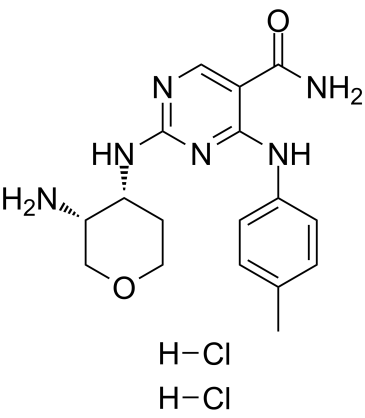GSK143 dihydrochloride
Modify Date: 2025-08-31 11:16:24

GSK143 dihydrochloride structure
|
Common Name | GSK143 dihydrochloride | ||
|---|---|---|---|---|
| CAS Number | 2341796-81-2 | Molecular Weight | 415.32 | |
| Density | N/A | Boiling Point | N/A | |
| Molecular Formula | C17H24Cl2N6O2 | Melting Point | N/A | |
| MSDS | N/A | Flash Point | N/A | |
Use of GSK143 dihydrochlorideGSK143 dihydrochloride is an orally active and highly selective spleen tyrosine kinase (SYK) inhibitor with a pIC50 of 7.5. GSK143 dihydrochloride inhibits phosphorylated Erk (pErk: pIC50=7.1)[1]. GSK143 dihydrochloride reduces inflammation and prevents recruitment of immune cells in the intestinal muscularis in mice[2][3]. |
| Name | GSK143 dihydrochloride |
|---|
| Description | GSK143 dihydrochloride is an orally active and highly selective spleen tyrosine kinase (SYK) inhibitor with a pIC50 of 7.5. GSK143 dihydrochloride inhibits phosphorylated Erk (pErk: pIC50=7.1)[1]. GSK143 dihydrochloride reduces inflammation and prevents recruitment of immune cells in the intestinal muscularis in mice[2][3]. |
|---|---|
| Related Catalog | |
| Target |
pIC50: 7.5 (SYK) and 7.1 (pErk)[1] |
| In Vitro | GSK143 dihydrochloride (compound 20) inhibits ZAP-70 (pIC50=4.7), LCK (pIC50=5.3), LYN (pIC50=5.4), JAK1/2/3 (pIC50=5.8/5.8/5.7), Aurora B (pIC50=4.8), hWB (pIC50=6.6), hERG (pIC50=4.7)[1]. GSK143 dihydrochloride (10-10000 nM; every 24 hours for 3 days) has an IC50 of 323 nM in CLL cells. GSK 143 dihydrochloride (1 μM; 30 mins) abrogates early signalling events including SYK phosphorylation and calcium flux[2]. GSK143 dihydrochloride (0.1-10 μM; for 30 min) reduces cytokine expression in bone marrow derived macrophages in a concentration-dependent manner[3]. Cell Viability Assay[2] Cell Line: Chronic lymphocytic leukaemia (CLL) cells Concentration: 10, 100, 1000, 10000 nM Incubation Time: Every 24 hours for 3 days Result: Had an IC50 of 323 nM. |
| In Vivo | GSK143 (0.1-10 mg/kg; orally; 1.5 hours) reduces inflammation and prevents recruitment of immune cells in the intestinal muscularis of 1 mg/kg[3]. GSK143 (3, 10, 30, 100 mg/kg; oral; 1 hour before ovalbumin challenge) reduces the cutaneous reverse passive Arthus reaction in a dose dependent manner by approximately 50% and 70% at 10 mg/kg and 30 mg/kg, respectively[2]. GSK143 (iv of 1 mg/kg; po of 3 mg/kg) has a T1/2 of 4.2 hours, low clearance (16 mL/min/kg), moderate bioavailability of 30% and a Vss of 4.1 L/kg in rats[1]. Animal Model: Wild type C57NL/BL6 mice, 10-12 weeks old[3] Dosage: 0.1, 1, 3, 10 mg/kg Administration: Orally; 1.5 hours before intestinal manipulation (IM) Result: Reduced inflammation and prevented recruitment of immune cells in the intestinal muscularis. Animal Model: Male CD rats (175-200 g)[1] Dosage: 1 mg/kg of iv; 3 mg/kg of po (Pharmacokinetic Analysis) Administration: IV or PO Result: Had a T1/2 of 4.2 hours, low clearance (16 mL/min/kg), moderate bioavailability of 30% and a Vss of 4.1 L/kg. |
| References |
| Molecular Formula | C17H24Cl2N6O2 |
|---|---|
| Molecular Weight | 415.32 |